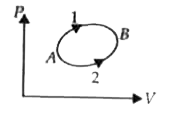
In the above diagram if a systems from initial state A goes to final state C from 3 different paths:
Path 1 is A to C, Path 2 is A to B to C, Path 3 is A to D to C
If 5 kJ of work is done by system in Path A to C then how much heat is transferred during Path A to D is:
The correct Answer is:0
Path A to D is adiabatic.
Topper's Solved these Questions
- MOCK TEST 2BOOK - VMC MODULES ENGLISHCHAPTER - MOCK TEST 2EXERCISE - PART II : CHEMISTRY (SECTION - 2)
10 Videos
- MOCK TEST 13BOOK - VMC MODULES ENGLISHCHAPTER - MOCK TEST 13EXERCISE - CHEMISTRY ( SECTION-2)
5 Videos
- MOCK TEST 3BOOK - VMC MODULES ENGLISHCHAPTER - MOCK TEST 3EXERCISE - PART II : CHEMISTRY (SECTION - 2)
10 Videos
Similar Questions
A gas with cpcV=γ goes from an intial state (p1,V1,T1) to a final state (p2,V2,T2) through an adiabatic process. The work done by the gas is
View SolutionA gas with cpcV=γ goes from an intial state (p1,V1,T1) to a final state (p2,V2,T2) through an adiabatic process. The work done by the gas is
View Solution
Knowledge Check
An ideal gas is transformed from state A(P1,V1) to the state B(P2,V2) through path AB. In this process the work done by the gas is
 AW = area ABCDABW = area ABEFACW = area ABGADW = area ABCOFA
AW = area ABCDABW = area ABEFACW = area ABGADW = area ABCOFAA gaseous system changes from state A(P1,V1,T1) to B(P2,V2,T2) to C(P3,V3,T3) and finally from C to A. The whole process may be called :
AReversible processBCyclic processCIsobaric processDSpontaneous processA gaseous system changes from state A(P1,V1,T1) to B(P2,V2,T2), B to C(P3,V3,T3) and finally from C to A. The whole process may be called
AReversible processBCyclic processCIsobaric processDSpontaneous process.
A system changes from the state (P1,V1) to (P2,V2) as shown in the diagram. The work done by the system is

View SolutionA system goes from P to Q by two different paths in the p−V diagram as shown in figure. Heat given to the system in path 1 is 1000 J. The work done by the system along path 1 is more than path 2 by 100 J. What is the heat exchanged by the system in path 2 ?

View SolutionA system goes from P to Q by two different paths in the p−V diagram as shown in figure. Heat given to the system in path 1 is 1000 J. The work done by the system along path 1 is more than path 2 by 100 J. What is the heat exchanged by the system in path 2 ?

View SolutionA gaseous system changes from state A(P1,V1,T1) to B(P2,V2,T2), B to C (P3,V3T3) and finally from C to A. The whole process may be called
View SolutionA system goes from P to Q by two different paths in the P-V diagram as shown in figure. Heat given to the system in path 1 is 1100 J, the work done by the system along path 1 is more than path 2 by 150 J. The heat exchanged by the system in path 2 is

View Solution
